About us
Objective
One of the major causes of failures of mechanical systems (e.g. drive trains, pitch systems, and yaw systems) in wind turbines is insufficient knowledge of the loads acting on these components. Within the seventh framework programme ENERGY [1]; [FP7-ENERGY-2007-1-RTD], ECN (The Energy Research Centre of the Netherlands) has taken the initiative to define the PROTEST (PROcedures for TESTing and measuring wind energy systems) project. The objective of this pre-normative project is to set up a methodology that enables better specification of design loads for the mechanical components. The design loads will be specified at the interfaces where the components can be "isolated" from the entire wind turbine structure as shown in the figure below. The project will assess if the presently used procedures for designing wind turbines as described in among others the IEC 61400-1 "Wind Turbine Generator Systems - Part 1: Design Requirements" and IEC 61400-4 Ed 1.0 "Wind Turbine Generator Systems - Part 4: Design and specification of gearboxes" contain sufficiently detailed information to determine the load cases and loads at the interfaces. If not, recommendations will be drafted for completion and improvement.
Schematized example of transformation of "global turbine loads" to loads and displacements at nine interfaces of mechanical components (gearbox, pitch system, and yaw system)
The focus of the project will be on developing guidelines for measuring load spectra at the interfaces during prototype measurements and to compare them with the initial design loads. Partly, the new guidelines can be considered as complementary to the IEC 614001-13 "Wind Turbine Generator Systems - Part 13: Measurement of mechanical loads". However, the new procedures will focus more on the validation of the models for component design. Such models may vary from simple analytical models (requiring simple measurement campaigns) to extensive multi body simulations (requiring more detailed measurements to verify the input parameters and responses).
Approach
The project team is a well balanced consortium consisting of a turbine manufacturer (Suzlon Energy), a gearbox manufacturer (Hansen Transmissions), a certification body (Germanischer Lloyd), R&D institutes (ECN, CRES, and the University of Stuttgart), and measurement institutes (DEWI, ECN, and CRES). The consortium will describe the current practice for designing and developing mechanical components. Based on this description, the project team will draft improved procedures for determining loads at the interfaces of mechanical components. The draft procedures will be applied, tested, and improved to three case studies with each a different focus, viz. determining and measuring loads at the drive train, the pitch system, and the yaw system; the latter one taking into account complex terrain. The project consists of 9 work packages (Work Package Leaders between brackets):
State of the art (University of Stuttgart): Making an inventory of the present day practice on turbine and component design and testing, including ongoing standardisation work and identification of areas for improvement.
Load cases and design drivers (ECN): For the selected components, it will be determined which load cases and design driving factors (external, operational or design inherent) should be considered
Loads at interconnection points (CRES): For the selected components, it will be specified how the loads at the design points should be documented with the aim of being a meaningful improvement over the current state-of-the-art (reporting format, time series incl. synchronisation and minimum frequencies, statistics, spectra, time-at-level, etc.)
Prototype measurements definition (ECN): For each component, a recommended measurement campaign will be defined taking into account:
- load cases,
- signals (torques, bending moments, forces, motions, accelerations, and decelerations),
- measurement frequencies,
- processing,
- uncertainties and inherent scatter,
- reporting.
The initial procedures developed in WP1 through WP4 will be applied to three case studies. In these case studies, the initial design loads at the interfaces of the components will be determined with state-of-the-art design methods and a measurement campaign will be executed to verify the models and design loads.
Case study 1: Drive train (Suzlon)
Case study 2: Pitch system (ECN)
Case study 3: Yaw system and drive train at complex terrain (CRES)
Evaluation and reporting (ECN): Based on the results of the design studies and the measurement results, the procedures of task 2, 3, and 4 will be evaluated and if necessary improved.
Management, Dissemination and Exploitation (ECN): The project results will be published on this website and visitors are invited to give feedback on the (draft) procedures. Final project results will be submitted to relevant wind energy standardisation committees.
Expected results
A state-of-the-art report containing the present day procedures for developing mechanical systems of wind turbines, taking into account the currently used design and simulation models, and the feedback from prototype measurements. The SOAR will also indicate white spots in the present day procedures and areas for improvement.
A report containing design load cases to be considered for specifying loads on drive trains, pitch systems and yaw systems. The project team will assess if the presently used set of design load cases is adequate for not only determining the global rotor and tower loads, but also for determining the design loads for mechanical components. If not, the report will specify additional load cases. Moreover, the project team will carry out parameter studies to adjust the level of detail and degrees of freedom of the various design models. Based on the outcome of these studies, the report will also include recommended practices for component modelling.
A report containing recommended practices to transfer global loads on the rotor and tower to design loads at the interfaces of the drive train, pitch system and yaw system, necessary to design the components. The recommended practices will also include procedures to incorporate in situ measurements to complete the set with design loads.
A report with recommended practices for measuring in situ the loads at the interfaces of mechanical components. The objective of these measurement campaigns is mainly to verify the design models. They may also reveal system behaviour that cannot be modelled at all with the currently used models. Aspects that will at least be considered are:
type of signal and corresponding sensor (i.e. torques, bending moments, accelerations, motions, rpm's, electrical power, shaft misalignment, etc.);
measurement frequency;
load cases to be measured, including frequency and duration (and thus minimum duration of measurement campaign);
data acquisition and processing, including generation of "calculated" or "pseudo" signals;
dynamic analyses;
uncertainty analyses;
reporting format (digital time series, tables, plots, statistics, rainflow count with load spectra, time-at-level, etc.) and interpretation of results;
assessment of measured loadings in relation to the design loads;
verification of model parameters and responses.
A report with the final recommended practices for determining and measuring loads at the interfaces. The procedures of the reports mentioned above will be applied to three case studies. Any findings from the case studies will be used to update the recommended practices and procedures.
Some members of the PROTEST consortium are also member of IEC working groups and other standardisation committees. They will ensure that the PROTEST results will be submitted to the relevant standardisation committees on wind energy. Furthermore, the (intermediate) PROTEST results will be published at wind energy conferences and work shops.

